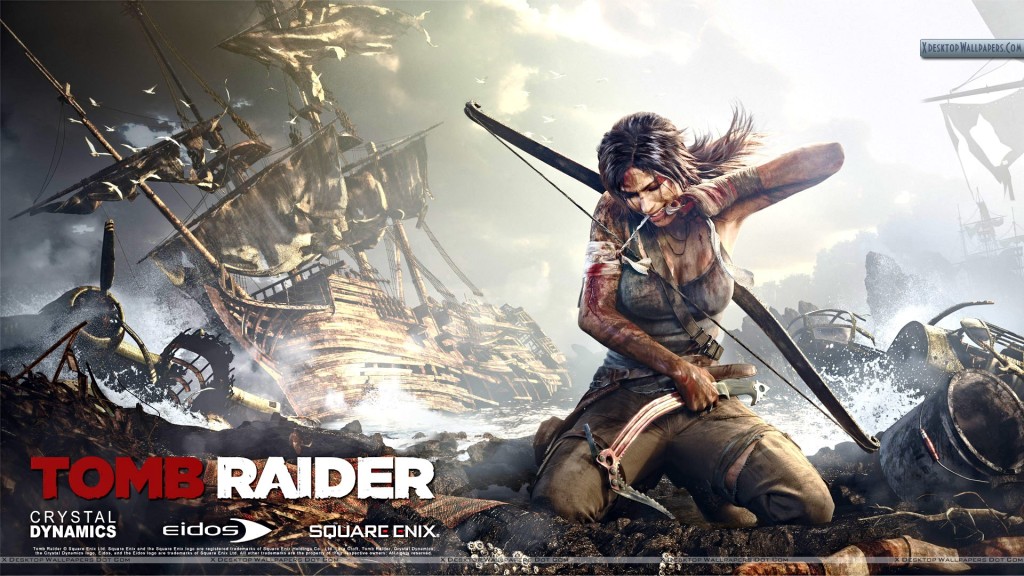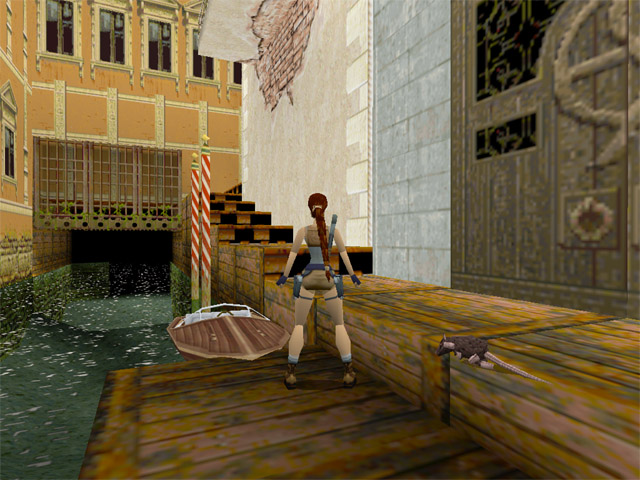Last updated on March 4, 2013

I’ve never understood the appeal of Tomb Raider as portrayed by most media outlets. While Entertainment Weekly, for example, might say thus:
Lara Croft had approximately 0.6 seconds as the adventurous, crypt-crawling Indiana Jane she was intended to be before she was immediately burdened with absurd physical proportions and tasked with propping up the half-formed sexual fantasies of millions of teenage boys. It’s a fact that mars her achievement as one of the first popular female protagonists in gaming—after all, Mario never had to look like Fabio — and shows that just because you’re polygonal, doesn’t mean you’re three-dimensional…
I’m sure that is some kind of discrimination right there. Who says that every young guy playing the game likes to, for lack of a better phrase to explain, ogle a woman’s hind quarters? I mean, seriously? Are teenagers that base in our culture that we train them to act this way? Maybe we just like Indiana Jones-style dungeon plumbing and Tomb Raiding (as in, hey, the title of the series!).
When I first played Tomb Raider, I got the second game in the series. Generally considered the worst, I had fun going through ancient forgotten cities, fighting mythological creatures and eventually fighting a dragon. Also, box puzzles. Lots of boring box puzzles. All of it seemed quite mysterious and ultimately derived from Lucas’ inspiration. Sure, a girl took the center spot, but that was neither here nor there to me. I came for the adventure and the excitement of the game’s themes, and not so much for the staring-at-polygonal-women part. Perhaps that became part of the appeal, but all I saw when I was nine years old (and even now) was a female protagonist in an action-adventure sci-fi/mythological atmosphere. Even the movies do much the same (even if they did not age particularly well).

But, of course, let’s portray this new one as “adult” and make sure to emphasize that it doesn’t objectify women at all. What a successful marketing scheme, in any event! I’ve only really noticed the primary issues as outlets point it out; inevitably, you might think the same way when someone beats one point, over and over again, into your head. When you see Conan O’Brien playing the new game and STILL objectifying the girl, the real situation’s obvious: nothing changed. She might have a smaller bosom (thanks for noticing!) which her TIGHT SHIRT makes rather obvious, but those pants still seem rather TIGHT even if they’re not HOT. So when EW, again, says this:
…But developer Crystal Dynamics is hoping to change all that with Tomb Raider, their upcoming reboot that hits stores March 5 and serves as a gritty origin story-slash-fresh start for Croft.
It’s almost like there’s an agenda here. A subtle one, but one nonetheless. I imagine we’ve all fallen into the preconceived narrative at one time or another, but let me lay it out clear: men designing women equals bad. Women designing women equals good. A radical feminist argument, to be sure, but definitely inherent in the atmosphere surrounding this game’s new-found “maturity”. Either way, you’re still looking at a woman’s behind when climbing up a sheer rockface, so I’m not sure what makes that radically different. Is it OK to objectify her if she represents the typical “strong” woman in our culture? I guess so! Or am I magically supposed to stop objectifying her…but American culture also taught me to do that in the first place! I’m getting some mixed messages here, guys! Should I follow nature or nurture? If science tells us that women and men alike objectify women, then why is there suddenly a moral component to a naturalist/materialist worldview?

Ah, delightful fallacies! We could make a further claim and state that placing women in men’s roles does not actually empower them at all, either. What, here, is the definition of “strong female”, anyway? Is it the Biblical one, or the one propped-up by some cultural faction attempting to grasp onto the trappings of power?
But I think my real objection doesn’t come from those who operate under those assumptions. The world functions as the world functions, and why should I expect them to break the cycle? Rather, I look at the Christian male (or female, but that’s a whole new problem) who, somehow, develops a problem with polygonal women. On the one hand, they want to blame the developers/authors of said video game for inciting lust. All well and good; they did a bad thing by making that woman appeal to men (which, by the way, is the purpose for which make-up came about, if you were wondering – not for a woman’s self-esteem), and you rightly pointed it out. Good job for you!
This does not solve the problem, though. Are you still lusting after said fake women to the degree that you must avert you eyes? Well, something wrong with you, then! It is your intentions that ruin the situation, not the game itself. Not every person struggles with the same sins – that much seems obvious in any church context. To make an overt generalization – say, that Tomb Raider objectifies women and therefore no one should play it – places a permanent Law onto a situation requiring Grace. Matthew 5 says:
27 “You have heard that it was said, ‘You shall not commit adultery’; 28 but I say to you that everyone who looks at a woman with lust for her has already committed adultery with her in his heart. 29 If your right eye makes you stumble, tear it out and throw it from you; for it is better for you to lose one of the parts of your body, than for your whole body to be thrown into hell. 30 If your right hand makes you stumble, cut it off and throw it from you; for it is better for you to lose one of the parts of your body, than for your whole body to go into hell.
God judges intentions first – they remain the progenitors of all actions. It is why, for example, we idolizes the conflict of the second World War in deference to the first. One, for whatever reason, represents the horrors of technology and senseless violence; the other shows the world a cause for which no one on earth would oppose in their right mind. The difference between one and the other becomes clear purely on the side of intentions – what reasons and intentions come into play?
Even so, Christianity and the world operate under different rules – what we know as Christians makes everything appear aright. When we observe sin, we know it comes from the paradigm from which we emerged – a fallen nature. But they do not know, nor do they adhere, to God’s standards. Why would they if they do not know what YOU know? So why do you intend to judge them or implicate them for it? The Christian’s first response can never be judgment, or else he falls right into the biggest trap of all, as Matthew 7 tells us:
“Do not judge so that you will not be judged. 2 For in the way you judge, you will be judged; and by your standard of measure, it will be measured to you. 3 Why do you look at the speck that is in your brother’s eye, but do not notice the log that is in your own eye? 4 Or how can you say to your brother, ‘Let me take the speck out of your eye,’ and behold, the log is in your own eye? 5 You hypocrite, first take the log out of your own eye, and then you will see clearly to take the speck out of your brother’s eye.
From that, we can assume that at no point can we judge sin without placing ourselves under judgement. Perhaps another word makes the point a little clearer: accusation. Unsurprisingly, the word “Sa-tan” translated to “the accuser”. That is what the Enemy does, his modus operandi – to accuse while we ourselves still retain many faults. It allows us to feel, temporarily, as if we were superior to the Other without changing ourselves. If you wish to change, if you want to truly live in the life of the Spirit, you cannot live with a judgmental spirit. You must cast it out, for Christ did the same for you. Or, as Paul might say in 1 Corinthians 4:
3 But to me it is a very small thing that I may be examined by you, or by any human court; in fact, I do not even examine myself. 4 For I am conscious of nothing against myself, yet I am not by this acquitted; but the one who examines me is the Lord. 5 Therefore do not go on passing judgment before the time, but wait until the Lord comes who will both bring to light the things hidden in the darkness and disclose the motives of men’s hearts; and then each man’s praise will come to him from God.
The problem, then, with any imagery promoted in a culture is that it will, if not guided by Christians and the like, tend towards sin. You cannot avoid it and you cannot escape it. But, through the process of sanctification and learning to become more Christlike, its affects become as mere nothing to you. See as Jesus hangs around with prostitutes and tax collectors, the Savior of the world wandering in the red light districts of antiquity! It isn’t the outside appearance – for all you know, they wore provocative clothing and did offensive things. But Jesus wasn’t offended; he saw the inner being and not the outer. He saw the good at first glance, and not the bad. Only God could judge because He is holy, yet he CHOOSES not to judge. We must act in the same way. Speak to the situation of the PERSON involved, not a generalization, and then the issue becomes clear. Objectification start with what you see, rather than what is actually there. Same goes for violence and whatever other sin gets portrayal in a video game.
Will you see the good in everything, or will you see the bad? I think you know my answer.
